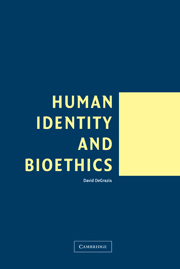Book contents
- Frontmatter
- Contents
- Acknowledgments
- 1 Introduction
- 2 Human Persons: Numerical Identity and Essence
- 3 Human Persons: Narrative Identity and Self-Creation
- 4 Identity, What We Are, and the Definition of Death
- 5 Advance Directives, Dementia, and the Someone Else Problem
- 6 Enhancement Technologies and Self-Creation
- 7 Prenatal Identity: Genetic Interventions, Reproductive Choices
- Index
2 - Human Persons: Numerical Identity and Essence
Published online by Cambridge University Press: 05 June 2012
- Frontmatter
- Contents
- Acknowledgments
- 1 Introduction
- 2 Human Persons: Numerical Identity and Essence
- 3 Human Persons: Narrative Identity and Self-Creation
- 4 Identity, What We Are, and the Definition of Death
- 5 Advance Directives, Dementia, and the Someone Else Problem
- 6 Enhancement Technologies and Self-Creation
- 7 Prenatal Identity: Genetic Interventions, Reproductive Choices
- Index
Summary
Penelope was pretty sure she wanted to go through with the operation. She understood that by now, in 2061, more than 100 people had undergone body transplants. As the surgeons explained to her, this is how it would work. A healthy thirty-year-old had agreed to be a body donor if she entered a permanent vegetative state (PVS). She had just been in a car accident that put her in PVS, and so, in accordance with her directive, her cerebrum was removed and discarded, making room for Penelope's. “But I thought someone in PVS wasn't legally dead,” Penelope worried aloud. “You're forgetting that in our state people can opt out of the default legal definition of death and declare that PVS will be considered death in their case,” a surgeon reminded her. “In her condition, the brainstem is still functional. After removing your cerebrum from your cancer-ridden body – which couldn't possibly survive for more than a few more months – we'll attach the cerebrum to her brainstem and nervous system. We're confident that within a few days of the operation you'll wake up to find yourself with a healthy new body!”
Penelope brimmed with optimism. Assuming the operation worked, someone would wake up with Penelope's functioning cerebrum and would apparently remember Penelope's life – including the decision to undergo the operation. “That person,” she mused “would be me.
- Type
- Chapter
- Information
- Human Identity and Bioethics , pp. 11 - 76Publisher: Cambridge University PressPrint publication year: 2005
- 1
- Cited by



